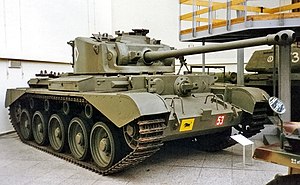Comet (tank)
| Tank, Cruiser, Comet I (A34) | |
|---|---|

A Comet tank on display at the Militärhistorisches Museum der Bundeswehr.
|
|
| Type | Cruiser tank |
| Place of origin | United Kingdom |
| Service history | |
| In service | December 1944 - 1958 (UK) |
| Used by | see Operators |
| Wars |
Second World War Korean War |
| Production history | |
| Designed | 1943 |
| Manufacturer | Leyland Motors Ltd |
| Produced | September 1944 |
| No. built | 1,186 |
| Specifications | |
| Weight | 32.7 long tons (laden) (33.53 tonnes) |
| Length | 21 ft 6 in (6.55 m) excluding gun |
| Width | 10 ft 1 in (3.04 m) |
| Height | 8 ft 6 in (2.67 m) |
| Crew | 5 (Commander, gunner, loader/operator, driver, hull gunner) |
|
|
|
| Armour | 1.3–4.0 in (32–102 mm) |
|
Main
armament |
77 mm HV 61 rounds |
|
Secondary
armament |
2 × 7.92 mm Besa MG 5,175 rounds |
| Engine |
Rolls-Royce Meteor Mark III V12 petrol 600 hp (447 kW) |
| Power/weight | 18 hp (13.3 kw) / tonne |
| Transmission | Merrit-Brown Z5 |
| Suspension | Christie |
| Ground clearance | 18 in (0.5 m) |
| Fuel capacity | 116 Imperial gallons |
|
Operational
range |
155 miles (250 km) |
| Speed | 32 mph (51 km/h) |
The Comet tank or Tank, Cruiser, Comet I (A34) was a British cruiser tank that first saw use near the end of the Second World War. It was designed as an improvement on the earlier Cromwell tank, mounting the new 77 mm HV gun in a new lower profile and part-cast turret. This gun was effective against late war German tanks, including the Panther and, at most ranges, the Tiger. The tank was widely respected as one of the best British tanks of the war, and continued in service afterwards.
Comet, which was a development of the Cromwell, rendered the Challenger obsolete, and led to the development of the Centurion tank. When firing APDS rounds, the 77 mm HV was a superior weapon to the 75 mm KwK 42 gun of the equivalent Axis tank, the Panther.
The Comet saw action in the closing stages of the Second World War, then combat during the Korean War, and remained in British service until 1958. In some cases, Comets sold to other countries continued to operate into the 1980s.
Combat experience against the Germans in the Western Desert Campaign demonstrated to the British many shortcomings with their cruiser tanks. Hence a request was made in 1941 for a new heavy cruiser tank that could achieve battle superiority over German models. For reasons of economy and efficiency, it had to use as many components as possible from the current A15 Cruiser tank Mk VI Crusader tank.
The initial designs for the new Cromwell tank evolved into the A24 Cruiser Tank Mk VII Cavalier tank and the A27L Cruiser tank Mk VII Centaur tank, both powered by the Nuffield Liberty. Design progressed through the Cruiser tank Mk VII (A27M) Cromwell, a third parallel development to the Cavalier and Centaur, sharing many of the same characteristics.
...
Wikipedia
